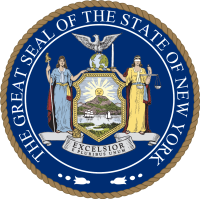Broome County, New York
Broome County in the U.S. state of New York, as of the 2010 United States Census, had a population of 200,600.[1] Its county seat is Binghamton. The county was named for John Broome, the state's lieutenant governor when Broome County was created.
Broome County | |
|---|---|
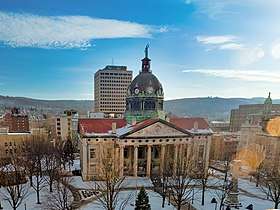 Broome County Courthouse | |
 Flag 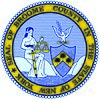 Seal | |
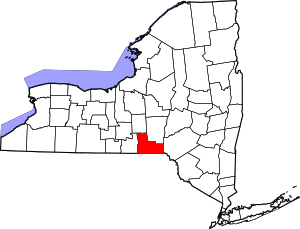 Location within the U.S. state of New York | |
 New York's location within the U.S. | |
| Coordinates: 42°08′13″N 75°53′18″W | |
| Country | |
| State | |
| Founded | 1806 |
| Named for | John Broome |
| Seat | Binghamton |
| Largest city | Binghamton |
| Government | |
| • County Executive | Jason T. Garnar |
| Area | |
| • Total | 715.52 sq mi (1,853.2 km2) |
| • Land | 705.77 sq mi (1,827.9 km2) |
| • Water | 9.7 sq mi (25 km2) 1.4% |
| Population | |
| • Estimate (2019) | 190,488 |
| • Density | 271.6/sq mi (104.9/km2) |
| Time zone | UTC−5 (Eastern) |
| • Summer (DST) | UTC−4 (EDT) |
| Congressional districts | 19th, 22nd |
| Website | www |
The county is part of the Binghamton, NY Metropolitan Statistical Area.
Broome County is the site of Binghamton University, one of four university centers in the State University of New York (SUNY) system.
History
When counties were established in the Province of New York in 1683, the present Broome County was part of the enormous Albany County, including the northern part of New York State as well as all of the present State of Vermont and, in theory, extending westward to the Pacific Ocean. This county was reduced in size on July 3, 1766 by the creation of Cumberland County, and further on March 16, 1770 by the creation of Gloucester County, both containing territory now in Vermont.
On March 12, 1772, what was left of Albany County was split into three parts, one remaining under the name Albany County. One of the other pieces, Tryon County, contained the western portion (and thus, since no western boundary was specified, theoretically still extended west to the Pacific). The eastern boundary of Tryon County was approximately five miles west of the present city of Schenectady, and the county included the western part of the Adirondack Mountains and the area west of the West Branch of the Delaware River. The area then designated as Tryon County now is organized as 37 counties of New York State. The county was named for William Tryon, colonial governor of New York.
In the years prior to 1776, most of the Loyalists in Tryon County fled to Canada. In 1784, following the peace treaty that ended the American Revolutionary War, the name of Tryon County was changed to Montgomery County, for General Richard Montgomery, who had captured several places in Canada and died attempting to capture the city of Quebec, thus replacing the name of the hated British governor.
In 1789, Montgomery County was reduced in size by the splitting off of Ontario County. The actual area split off from Montgomery County was much larger than the present county, also including the present Allegany, Cattaraugus, Chautauqua, Erie, Genesee, Livingston, Monroe, Niagara, Orleans, Steuben, Wyoming, Yates, and part of Schuyler and Wayne Counties.
In 1791, Tioga County split off from Montgomery County, along with Herkimer and Otsego Counties. Tioga County was at this time much larger than the present county and included the present Broome and Chemung Counties and parts of Chenango and Schuyler Counties.
In 1798, Tioga County was reduced in size by the splitting off of Chemung County (which also included part of the present Schuyler County) and by the combination of a portion with a portion of Herkimer County to create Chenango County.
In 1806, the present-day Broome County was split off from Tioga County.[2]
Geography
Broome County lies on the south line of New York. Its south border abuts the north border of the state of Pennsylvania. The Susquehanna River flows southward through the eastern part of the county, enters Susquehanna County in Pennsylvania, then re-enters Broome and flows northwestward to meet the Chenango River at Binghamton. The combined flow moves west-southwestward into Tioga County to the west. The West Branch Delaware River flows southward along the lower portion of the county's east border, delineating that portion of the border between Broome and Delaware counties.[3]
The county's western portion is hilly, with wide valleys that accommodate Binghamton and its suburbs. In the northern portion, Interstate 81 traverses a wide glacial valley. The east part of the county is much more rugged, as the land rises to the Catskill Mountains. The terrain generally slopes to the west.[4] The county's highest point is in the northwest of the county, a U.S. National Geodetic Survey benchmark known as Slawson atop an unnamed hill in the Town of Sanford. It is approximately 2087 feet[5] (636 m) above sea level.[6] An area due east on the Delaware County line in Oquaga Creek State Park also lies within the same elevation contour line. The lowest point is 864 feet (263 m) above sea level, along the Susquehanna River, at the Pennsylvania state line.
The county has a total area of 716 square miles (1,850 km2), of which 706 square miles (1,830 km2) is land and 9.7 square miles (25 km2) (1.4%) is water.[7]
Adjacent counties
- Chenango County - northeast
- Delaware County - east
- Wayne County, Pennsylvania - southeast
- Susquehanna County, Pennsylvania - south
- Tioga County - west
- Cortland County - northwest
Protected areas[3]
- Aqua-Terra Wilderness Area
- Beaver Flow State Forest (part)
- Beaver Pond State Forest
- Cascade Valley State Forest
- Cat Hollow State Forest
- Chenango Valley State Park
- Dorchester County Park
- Greenwood County Park (part)
- Hawkins Pond State Forest
- Marsh Pond State Forest
- Nathaniel Cole County Park
- Oquaga Creek State Park (part)
- Skyline Drive State Forest
- Triangle State Forest
- Whitney Point Multiple Use Area (part)
- Whittacker Swamp State Forest
Lakes[3]
- Agwaterra Pond
- Blueberry Lake
- Deer Lake
- Fly Pond
- Hawkins Pond
- Hust Pond
- Laurel Lake
- Nanticoke Lake
- Oquaga Lake
- Otselic River
- Potato Creek
- Sky Lake
- Summit Lake
Major highways
Climate
Broome has a warm-summer humid continental climate (Dfb) and the hardiness zone is mainly 5b.
| Binghamton, New York | ||||||||||||||||||||||||||||||||||||||||||||||||||||||||||||
|---|---|---|---|---|---|---|---|---|---|---|---|---|---|---|---|---|---|---|---|---|---|---|---|---|---|---|---|---|---|---|---|---|---|---|---|---|---|---|---|---|---|---|---|---|---|---|---|---|---|---|---|---|---|---|---|---|---|---|---|---|
| Climate chart (explanation) | ||||||||||||||||||||||||||||||||||||||||||||||||||||||||||||
| ||||||||||||||||||||||||||||||||||||||||||||||||||||||||||||
| ||||||||||||||||||||||||||||||||||||||||||||||||||||||||||||
Demographics
| Historical population | |||
|---|---|---|---|
| Census | Pop. | %± | |
| 1810 | 8,130 | — | |
| 1820 | 14,343 | 76.4% | |
| 1830 | 17,579 | 22.6% | |
| 1840 | 22,338 | 27.1% | |
| 1850 | 30,660 | 37.3% | |
| 1860 | 35,906 | 17.1% | |
| 1870 | 44,103 | 22.8% | |
| 1880 | 49,483 | 12.2% | |
| 1890 | 62,973 | 27.3% | |
| 1900 | 69,149 | 9.8% | |
| 1910 | 78,809 | 14.0% | |
| 1920 | 113,610 | 44.2% | |
| 1930 | 147,022 | 29.4% | |
| 1940 | 165,749 | 12.7% | |
| 1950 | 184,698 | 11.4% | |
| 1960 | 212,661 | 15.1% | |
| 1970 | 221,815 | 4.3% | |
| 1980 | 213,648 | −3.7% | |
| 1990 | 212,160 | −0.7% | |
| 2000 | 200,536 | −5.5% | |
| 2010 | 200,600 | 0.0% | |
| Est. 2019 | 190,488 | [9] | −5.0% |
| US Decennial Census[10] 1790-1960[11] 1900-1990[12] 1990-2000[13] 2010-2019[1] | |||
2000 census
As of the 2000 United States Census,[14] there were 200,536 people, 80,749 households, and 50,225 families in the county. The population density was 284/1/sqmi (109.7/km²). There were 88,817 housing units at an average density of 125.8/sqmi (48.6/km²). The racial makeup of the county was 91.33% White, 3.28% Black or African American, 0.19% Native American, 2.79% Asian, 0.03% Pacific Islander, 0.79% from other races, and 1.59% from two or more races. 1.99% of the population were Hispanic or Latino of any race. 16.1% were of Irish, 13.3% Italian, 12.3% German, 11.6% English, 6.4% American and 5.7% Polish ancestry according to Census 2000.[15] 91.4% spoke English, 2.0% Spanish and 1.1% Italian as their first language.
There were 80,749 households out of which 28.20% had children under the age of 18 living with them, 47.60% were married couples living together, 10.80% had a female householder with no husband present, and 37.80% were non-families. 31.00% of all households were made up of individuals and 12.40% had someone living alone who was 65 years of age or older. The average household size was 2.37 and the average family size was 2.97.
The county population contained 23.00% under the age of 18, 11.00% from 18 to 24, 26.80% from 25 to 44, 22.80% from 45 to 64, and 16.40% who were 65 years of age or older. The median age was 38 years. For every 100 females there were 93.20 males. For every 100 females age 18 and over, there were 89.90 males.
The median income for a household in the county was $35,347, and the median income for a family was $45,422. Males had a median income of $34,426 versus $24,542 for females. The per capita income for the county was $19,168. About 8.80% of families and 12.80% of the population were below the poverty line, including 15.90% of those under age 18 and 7.20% of those age 65 or over.
Government and politics
For the past few decades, Broome County has been a swing unit. Since 1964 the county has selected Democratic and Republican party candidates at approximately the same rate in national elections (as of 2016). The more recent elections had favored the Democratic candidate, until Donald Trump carried the county in 2016, the first Republican to win the county since Ronald Reagan in 1984.
| Year | Republican | Democratic | Third parties |
|---|---|---|---|
| 2016 | 47.6% 40,943 | 45.6% 39,212 | 6.9% 5,917 |
| 2012 | 46.2% 37,641 | 51.5% 41,970 | 2.4% 1,954 |
| 2008 | 45.1% 40,077 | 53.1% 47,204 | 1.8% 1,556 |
| 2004 | 47.4% 43,568 | 50.4% 46,281 | 2.2% 2,041 |
| 2000 | 42.4% 36,946 | 52.1% 45,381 | 5.5% 4,757 |
| 1996 | 36.1% 31,327 | 51.2% 44,407 | 12.8% 11,080 |
| 1992 | 34.7% 34,653 | 43.5% 43,444 | 21.8% 21,749 |
| 1988 | 49.4% 47,610 | 50.0% 48,130 | 0.7% 625 |
| 1984 | 60.5% 58,109 | 39.2% 37,658 | 0.3% 322 |
| 1980 | 44.0% 39,275 | 41.5% 37,013 | 14.6% 12,992 |
| 1976 | 55.5% 50,340 | 43.9% 39,827 | 0.5% 491 |
| 1972 | 59.8% 55,736 | 39.9% 37,154 | 0.3% 245 |
| 1968 | 52.5% 46,872 | 41.9% 37,451 | 5.6% 4,988 |
| 1964 | 35.2% 32,048 | 64.8% 59,021 | 0.1% 70 |
| 1960 | 59.4% 56,467 | 40.5% 38,462 | 0.1% 62 |
| 1956 | 74.3% 67,024 | 25.7% 23,217 | 0.0% 0 |
| 1952 | 71.4% 64,738 | 28.5% 25,833 | 0.1% 119 |
| 1948 | 60.7% 43,110 | 36.1% 25,654 | 3.1% 2,222 |
| 1944 | 58.5% 44,013 | 41.3% 31,056 | 0.2% 137 |
| 1940 | 57.7% 44,013 | 42.1% 32,092 | 0.2% 179 |
| 1936 | 54.7% 36,945 | 43.9% 29,708 | 1.4% 950 |
| 1932 | 58.0% 32,751 | 40.4% 22,802 | 1.7% 941 |
| 1928 | 65.3% 39,860 | 32.0% 19,563 | 2.7% 1,669 |
| 1924 | 67.7% 28,262 | 22.3% 9,289 | 10.1% 4,198 |
| 1920 | 69.0% 24,759 | 25.8% 9,251 | 5.3% 1,893 |
| 1916 | 53.3% 11,445 | 41.5% 8,906 | 5.2% 1,105 |
| 1912 | 43.6% 7,949 | 35.8% 6,533 | 20.7% 3,770 |
| 1908 | 58.2% 10,705 | 36.2% 6,671 | 5.6% 1,032 |
| 1904 | 59.5% 10,853 | 35.6% 6,480 | 4.9% 897 |
| 1900 | 58.0% 10,397 | 37.1% 6,652 | 4.9% 877 |
| 1896 | 63.8% 10,630 | 32.8% 5,461 | 3.5% 583 |
| 1892 | 52.4% 8,259 | 38.3% 6,040 | 9.3% 1,474 |
| 1888 | 53.7% 8,405 | 41.2% 6,447 | 5.1% 801 |
| 1884 | 53.0% 7,182 | 42.6% 5,780 | 4.4% 602 |
Broome County's offices are housed in the Edwin L. Crawford County Office Building of Government Plaza located at 60 Hawley Street in Downtown Binghamton.
Executive
| Name | Party | Term |
|---|---|---|
| Edwin L. Crawford | Republican | 1969–1976 |
| Donald L. McManus | Democratic | 1977–1980 |
| Carl S. Young | Republican | 1981–1988 |
| Timothy M. Grippen | Democratic | 1989–1996 |
| Jeffrey P. Kraham | Republican | 1997–2004 |
| Barbara J. Fiala | Democratic | 2005–Apr. 15, 2011 |
| Patrick J. Brennan | Democratic | Apr. 16, 2011–Dec. 31, 2011 |
| Debra A. Preston | Republican | Jan. 1, 2012–Dec. 31, 2016 |
| Jason T. Garnar[17] | Democratic | Jan. 1 2017– |
Legislature
The Broome County Legislature consists of 15 members.[18] The 15 legislature members are elected from individual districts. Currently, there are 10 Republicans and 5 Democrats.
| District | Legislator | Title | Party | Residence |
|---|---|---|---|---|
| 1 | Stephen J. Flagg | Republican | Colesville | |
| 2 | Scott D. Baker | Republican | Windsor | |
| 3 | Kelly F. Wildoner | Republican | Binghamton | |
| 4 | Kim A. Myers | Democratic | Vestal | |
| 5 | Daniel J. Reynolds | Chairman | Republican | Vestal |
| 6 | Greg W. Baldwin | Republican | Endicott | |
| 7 | Matthew J. Pasquale | Republican | Endicott | |
| 8 | Jason E. Shaw | Republican | Endwell | |
| 9 | Matthew J. Hilderbrant | Republican | Whitney Point | |
| 10 | Cindy O'Brien | Majority Leader | Republican | Chenango |
| 11 | Susan V. Ryan | Democratic | Binghamton | |
| 12 | Richard P. Balles | Republican | Johnson City | |
| 13 | Robert Weslar | Democratic | Binghamton | |
| 14 | Mary Kaminsky | Minority Leader | Democratic | Binghamton |
| 15 | Mark R. Whalen | Democratic | Binghamton |
Party affiliation
| Party | Active voters | Inactive voters | Total voters | Percentage | |
|---|---|---|---|---|---|
| Democratic | 42,121 | 4,361 | 46,482 | 37.23% | |
| Republican | 41,172 | 2,635 | 43,807 | 35.08% | |
| Unaffiliated | 21,996 | 2,991 | 24,987 | 20.01% | |
| Other[nb 1] | 8,609 | 981 | 9,590 | 7.68% | |
| Total | 113,898 | 10,968 | 124,866 | 100% | |
Education
The primary institutes of higher education in Broome County include:
- Binghamton University (enrollment 16,000)
- Broome Community College (BCC)
- Davis College - a private Christian college in Johnson City
Communities
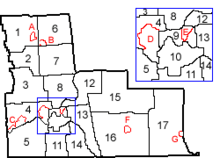
City
- Binghamton (county seat)
Towns
Census-designated places
Hamlets
Notable people
- John Allen, dentist and inventor of new denture method[20]
- Ira Cook (1821-1902), Iowa land surveyor and businessman, born in Broome County[21]
- Daniel S. Dickinson (1800-1866), US Senator, lived in Broome County
- John Ducey (1969- ), actor, born in Broome County
- Barzillai Gray (1824–1918), judge, born in Broome County
- Robert Harpur (1731-1825), colonial teacher, politician, pioneer, for whom Harpur College (now Binghamton University) was named. Settled at Harpursville.
- Johnny Hart (1931-2007), cartoonist, creator of B.C. and co-creator of The Wizard of Id. Born in Broome County.
- George F. Johnson (1857-1948), industrialist, philanthropist, co-founder of Endicott-Johnson Co. Lived in Broome County.
- Willis Sharpe Kilmer (1867-1940), industrialist and entrepreneur[22][23][24] Lived in Broome County.
- Edwin A. Link (1904-1981), inventor, raised in Broome County.
- David Ross Locke (1833-1888), Civil War journalist. Born in Broome County.
- Ron Luciano (1937-1995), baseball umpire, author. Born in Broome County.
- Billy Martin (1928-1989), baseball player, manager. Retired to Broome County.
- Leonard Melfi (1932-2001), author, playwright. Born in Broome County
- William L. Mercereau (1866-1957), businessman, superintendent of carferries. Born in Broome County
- Mary Blair Moody (1837-1919), physician, anatomist. Born in Broome County.
- Hidy Ochiai (1939- ), karate and judo grand master, author, actor. Resides in Broome County.
- Camille Paglia (1947- ), philosopher, author. born in Broome County.
- Alice Freeman Palmer (1855-1902), educator. Born in Broome County.
- Amy Sedaris (1961- ), actress, author, playwright. Born in Broome County.
- David Sedaris (1956- ), comedian, essayist, playwright. Born in Broome County.
- Rod Serling (1924-1975), screenwriter, playwright. Raised in Broome County.
- Jack Sharkey (1902-1994), born Joseph Paul Cukoschay, world heavyweight boxing champion, 1931–33. Born in Broome County.
See also
Notes
- Included are voters affiliated with the Conservative Party, Green Party, Working Families Party, Independence Party, Women's Equality Party, Reform Party, and other small parties.
References
- "State & County QuickFacts". United States Census Bureau. Archived from the original on July 7, 2011. Retrieved October 11, 2013.
- A Brief History of Broome County (accessed 14 June 2019)
- Broome County NY - Google Maps (accessed 14 June 2019)
- "Find an Altitude/Broome County NY - Google Maps (accessed 14 June 2019)". Archived from the original on 21 May 2019. Retrieved 15 June 2019.
- "Hiking in Broome County". www.cnyhiking.com.
- Another website lists the Benchmark's elevation as 2,080' (634m) ASL: Slawson Benchmark, New York (PeakBagger.com) Accessed 14 June 2019
- "2010 Census Gazetteer Files". US Census Bureau. August 22, 2012. Archived from the original on May 19, 2014. Retrieved January 3, 2015.
- "NowData – NOAA Online Weather Data". National Oceanic and Atmospheric Administration. Retrieved 2017-02-25.
- "Population and Housing Unit Estimates". Retrieved May 21, 2020.
- "US Decennial Census". US Census Bureau. Retrieved January 3, 2015.
- "Historical Census Browser". University of Virginia Library. Retrieved January 3, 2015.
- "Population of Counties by Decennial Census: 1900 to 1990". US Census Bureau. Retrieved January 3, 2015.
- "Census 2000 PHC-T-4. Ranking Tables for Counties: 1990 and 2000" (PDF). US Census Bureau. Retrieved January 3, 2015.
- "U.S. Census website". US Census Bureau. Retrieved 31 January 2008.
- "U.S. Census website". Retrieved 2008-03-04.
- Leip, David. "Atlas of US Presidential Elections". uselectionatlas.org.
- "County Executive - Jason T. Garnar | broomecountyny". www.gobroomecounty.com. Retrieved 2017-01-30.
- "Welcome to the Broome County Legislature - broomecountyny". www.gobroomecounty.com.
- "NYSVoter Enrollment by County, Party Affiliation and Status" (PDF). New York State Board of Elections. April 2018. Archived from the original (PDF) on July 30, 2016. Retrieved May 2, 2018.
- Who Was Who in America, Historical Volume, 1607-1896. Chicago: Marquis Who's Who. 1963.
- "Ringgold County IAGenWeb Project". iagenweb.org.
- History of the City of Binghamton
- Life & Times Part 1
- Life & Times Part 2
External links
| Wikimedia Commons has media related to Broome County, New York. |
- Broome County, New York
- Broome County at Curlie
- Summary Early history of Broome County
- BingWiki, the area's local regional wiki
- Broome County Oral History Project, Binghamton University Libraries
